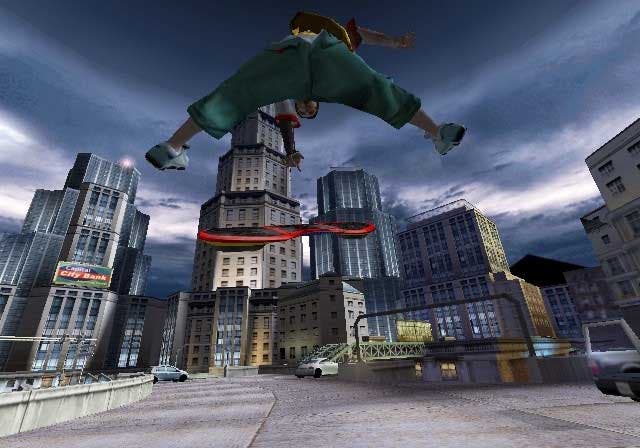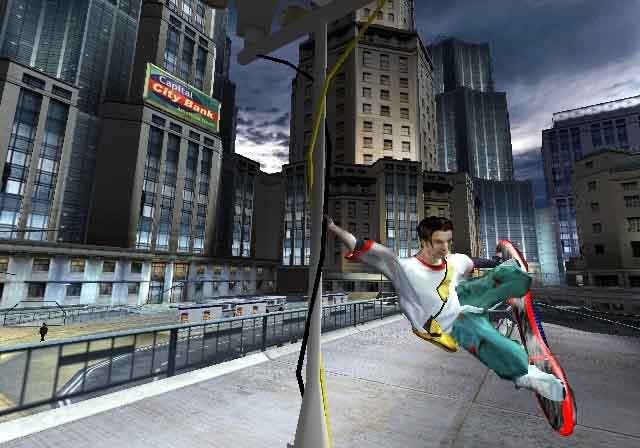Airblade
Review - futuristic competition for SSX, or lousy Renderware demonstration?

Back To The Drawing Board
You remember Trickstyle, right? It was an intriguing idea, a racing game on hoverboards, but it turned out to be a pretty uninspiring and soulless affair (and took about an hour to finish -Ed). Now, some two-and-a-bit years later, Criterion have taken the idea that could easily have been inspired by Back to the Future Part II and fused it with their lucrative middleware engine, Renderware, to bring us something far more interesting. The focus of Airblade's single-player game is placed on the story mode. Our hero, Ethan, has come into possession of a hoverboard prototype that was being worked on by one of his shady cohorts. Attempting to get their grubby mitts on this prototype is the GCP Corporation, and having taken Ethan and his partner in crime Kat's best mate hostage, the kids set out on a quest to thwart their evil megaglobal domination-type plans and well and truly .. ahem .. "stick it to the man". What follows is a floaty jaunt around six sprawling levels, attempting to achieve objectives provided by Kat via intercom. The objectives range from taking out GCP guards by hurtling towards them and performing a trick on their face, to flinging your hapless boarder impressively into the air to break searchlights. Why he couldn't just use a rock or something is beyond me...

Acrobatic
Controlling Ethan is at first more tricky than you would anticipate. Having cut my teeth on games that utilise forms of transport that are affected by friction, such as that of our old pal Tony Hawk, Ethan's floating plank felt strange and slippery to me at first. The initial training mode helps overcome this however, and before long the control system feels remarkably intuitive, and it's possible to produce some impressive moves despite its simplicity, including the daring feat of swinging from poles and somersaulting into the air by grabbing onto horizontal bars. You don't have to charge up your ollies to jump higher, which takes some getting used to. Instead, performing tricks will fill up a "boost meter" in the corner of the screen, and you can use this boost via R2 to jump higher and glide further. This can also be utilised to hurtle across the ground at an amazing speed, which is especially handy as the time limit on some of the levels can be overly strict. The gameplay is a significant nod towards the playing style of Jet Set Radio, and to a lesser extent the Tony Hawk's series. As objectives are given to you, an arrow at the top of the screen points you in the general direction of your target, but it's up to you to decide how you're going to get there. This can often end up as an exercise in frustration, as the level designers rarely offer decent visual clues as to where you might need to be going. For example, on the first city street level the final objective is to gain access to the roof of a building by grinding along the broken pylon, and the only information you get is "Use the broken pylon to get up there" and an arrow pointing up. Handy.

On Rails
Encouraging the player to explore the levels and find the best routes wouldn't be so bad if failure wasn't such a huge setback. I can deal with falling from a rooftop a few times in an attempt to make a grind, but falling from a rooftop a few times until your time runs out and then having to perform all the previous objectives all over again is an unwelcome chore, and arguably the reason that Jet Set Radio lost its charm so quickly. It's because of this linearity that Airblade shoots itself in the foot. You are mostly forced to perform tasks in a specific order, and this rids the story mode of the freedom that makes Tony Hawk so engaging. This hits home as quite a shame, because Criterion have produced a game with a lot of potential and to trip up on such a trivial matter seems a stupid mistake to make. Elsewhere, the game is peppered with the usual extras we've come to expect from this kind of title. There are freestyle and score attack modes, which offer a limited diversion from the main storyline, and there's also a fairly good split screen multiplayer mode. Of particular note is the Ribbon Tag game, where players chase each other about the environments trying to grab the gradually lengthening police tape being dragged along behind the player like the puppy in the Andrex advert.

Just A Pretty Face?
Presentation-wise, there really aren't many complaints. The engine is perfectly capable of delivering nicely detailed and convincing areas to leap about in, and the textures and spot effects are good, if unremarkable. Character animation is also good, and Ethan flinging his board about and performing all kinds of gravity-defying acrobatics is pleasantly convincing. The sound is less satisfying than the visuals, though. Voice acting both in-game and throughout the cut-scenes between levels is just annoying. Ethan careers about screeching "You wanna piece of me?!" with Keanu Reeves' irritating nasal whine, and the cast of security guards and villains leaves a fair amount to be desired, even for a game that's obviously not taking itself too seriously. In all, Airblade is a promising concept ruined by some lazy level design and infuriating linearity. It may be worth Criterion giving the franchise another chance should they take note of the game's shortcomings, as it could have been a brilliant diversion from the glut of skating titles we're forced to put up with. It makes a nice demonstration of Renderware's capabilities, but as a game, well, better luck next time?

